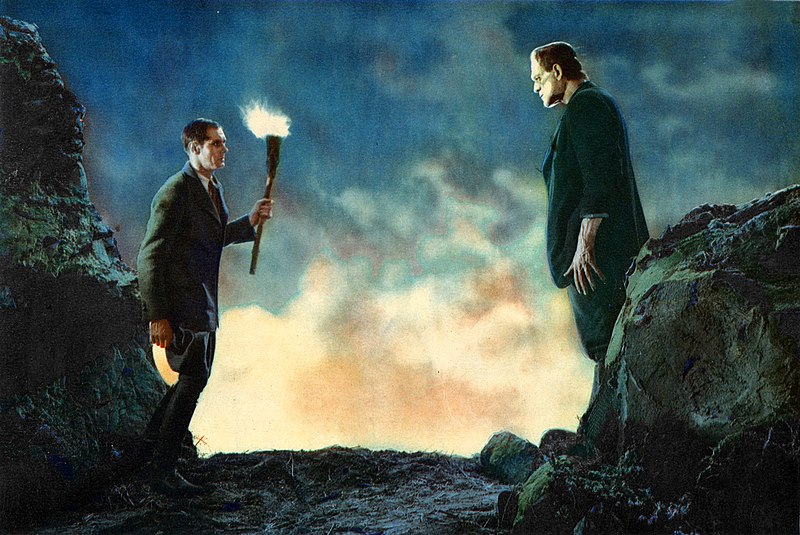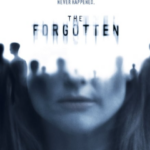Frankenstein (1931)
“Now I know how it feels to be God.” That line in this film, uttered by a raving Henry Frankenstein right after he brought his patched-together-from-cadavers man to life, sums up all the blasphemy, megalomania and sheer cruelty inherent in every attempt to “be as God” (Genesis 3:5).

Frankenstein, of course, in his utter amorality has no idea what it is like to be the good God, and he bears zero resemblance to the Creator. Nor is he even a creator; after all, God created the people whose bodies and organs Frankenstein stole from graveyards, the gallows, and a medical school. This recalls the story of the egomaniacal man who bet God he too could create a world; when the man said, “I’ll start with this dirt here,” God interrupted him and said, “Just a minute! Get your own dirt.”
The film loosely follows the 1818 novel Frankenstein; Or, The Modern Prometheus, which Mary Wollstonecraft Godwin Shelley (1797-1851) wrote in 1816 (yes, at age 19). Greek mythology’s Prometheus, the Titan who made mankind from clay, incurred dire punishment for disobeying “the gods” by stealing fire and giving it to humanity. Like him, Mary Shelley’s scientist Victor Frankenstein reaps severe consequences when he tries to usurp God’s role and mess with human nature. The same with the movie’s Henry Frankenstein, except the repercussions get sanitized somewhat.
The movie opens with a break-the-fourth-wall warning to us, the viewers, by a super-smarmy Edward Van Sloan (who later plays Doctor Waldman in the film) that if we think we’ll be too shocked by the film we might reconsider watching it. Naturally, that’s a come-on to the audience. Before long we see mourners at a grave site, a gravedigger at his task, and Henry Frankenstein (Colin Clive) and his overeager assistant Fritz (Dwight Frye) frenetically digging up the coffin after everyone else has left.
Later, at his boss’s behest, Fritz steals a human brain-in-a-jar from a medical school – but it’s one labeled “Abnormal,” because he’s shattered the one marked “Normal” that he was supposed to get. Trouble ahead! We now segue to Frankenstein’s fiancée Elizabeth (Mae Clarke), who’s fretting because he’s isolated himself in an old watchtower for experiments of some kind. She and friend Victor Moritz persuade Frankenstein’s old mentor, Doctor Waldman (Van Sloan), to take them to him.
They arrive on a dark and stormy night – what else? – and in a fearsome and famous scene become witnesses to Frankenstein’s bringing his creature (Boris Karloff) to life with the help of wild thunder and lightning. The crazed Frankenstein triumphantly screams, “It’s alive!” over and over. When Victor remonstrates, “In the name of God, Henry,” Frankenstein, as we’ve seen above, blasphemes that he now knows how it feels to be God.
They ought to cart Henry out in a straitjacket right now, but instead they leave, even though Victor has called him crazy and Waldman has earlier referred to Henry’s “mad dream” of wanting to create human life. May more voices today sound the tocsin in similar terms to warn the world against cloning and other human experimentation.
Frankenstein decides his Monster is dangerous, so he cruelly chains him in a dungeon-like cell, where Fritz terrifies him with a torch until the Monster grabs and kills him (off screen, unlike in today’s grisly films). Henry and Waldman tranquilize the Monster into unconsciousness. Waldman promises to euthanize him, letting Henry go home to calm down and prepare for his wedding. (Why Elizabeth would still want him is anyone’s guess.) Before long the Monster suddenly awakens, strangles Waldman, and escapes into the countryside, unbeknownst to Henry.
The evil consequences of Frankenstein’s toying with human life now unfold. For example, the Monster accidentally kills a little girl (Marilyn Harris). Incidentally, in being distraught at what happened, the “creature” shows much more humanity than the scientist whose living, tragic experiment he is. Things descend further, into – SPOILER ALERT – a sad ending for the Monster but an incongruously happy one for everyone else. And no one considers prosecuting Frankenstein for his obvious crimes.
Henry Frankenstein forgot, or ignored, the Scripture verse: “Just as it is appointed that men die once, and after this the judgment…” (Hebrews 9:27). Two centuries ago Mary Shelley foresaw the evils created by anyone like Henry who would try to supplant the Creator. So did this film nearly 90 years ago. The real monster was not the Monster but Frankenstein himself.
The film carried no rating; it preceded the enforcement, starting in 1934, of the Motion Picture Production Code (“A Code to Govern the Making of Motion Pictures”). The movie’s grotesque images include, of course, the Monster’s head and overall appearance, but also scenes of intense menace; grave-robbing; handling of jars containing human brains; a hanged man; a child thrown into a lake and not reappearing; a father carrying his lifeless child; strangulation; a planned euthanizing; a sadist tormenting the chained Monster with a torch; townsmen pursuing the Monster and setting a windmill on fire; and – SPOILER ALERT – the Monster trapped in a burning room.
Carl Laemmle, Jr., produced the film and James Whale directed. Francis Edward Faragoh and Garrett Fort wrote the script with uncredited help from Robert Florey and John Russell, based on the 1818 novel Frankenstein; Or, The Modern Prometheus, by Mary Shelley and on John L. Balderston’s story adaptation of Peggy Webling’s play, Frankenstein. Richard Schayer was scenario editor. Bernhard Kaun was the composer and Arthur Edeson the cinematographer. Jack Pierce was the makeup artist.
— Dan Engler













